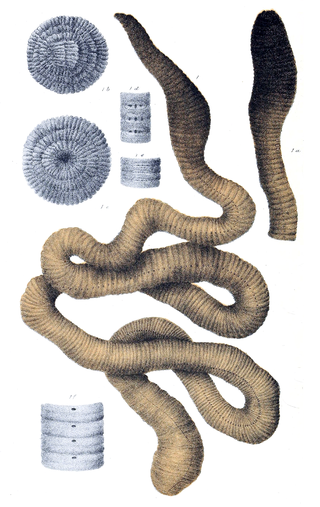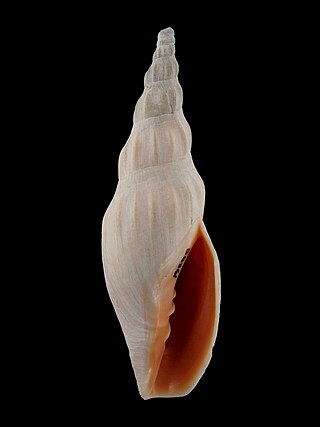
Oligochaeta is a subclass of soft-bodied animals in the phylum Annelida, which is made up of many types of aquatic and terrestrial worms, including all of the various earthworms. Specifically, oligochaetes comprise the terrestrial megadrile earthworms, and freshwater or semiterrestrial microdrile forms, including the tubificids, pot worms and ice worms (Enchytraeidae), blackworms (Lumbriculidae) and several interstitial marine worms.

Megascolecidae is a family of earthworms native to Madagascar, Australia, New Zealand, Asia, and North America. All species of the Megascolecidae belong to the Clitellata class. The Megascolecidae comprise a large family of earthworms and they can grow up to 2 meters in length. The intercontinental distribution of Megascolecidae species favours the continental drift theory.

The giant Gippsland earthworm, is one of Australia's 1,000 native earthworm species.
The Eudrilidae are a family of earthworms, mostly of Africa. One species, Eudrilus eugeniae, is widely distributed around the warmer parts of the world and historically cultured as the "African nightcrawler".
Pristimantis ernesti is a species of frog in the family Strabomantidae. It is endemic to the summit of Sumaco, a volcano in the Napo Province, Ecuador. Its common name is Ernest's robber frog. It is named after Dr. Ernst Williams, a friend and colleague of the scientist that described the species. It is a little studied species.
The Oregon giant earthworm is one of the largest earthworms found in North America, growing to more than three feet in length. First described in 1937, the species is not common. Since its discovery, specimens have been documented in only fifteen locations within Oregon's Willamette Valley.

Alcithoe larochei is a species of large deepwater sea snail, a marine gastropod mollusc in the family Volutidae, the volutes.

Alcithoe flemingi is a species of large sea snail, a marine gastropod mollusc in the family Volutidae, the volutes.

Archontophoenix cunninghamiana – commonly known as Bangalow palm, king palm, Illawara palm or piccabeen palm – is a tree in the palm family Arecaceae, which is endemic to the east coast of New South Wales and Queensland, Australia.
The Acanthodrilidae are an ancient and widely distributed family of earthworms which has native representatives in Australia, New Zealand, South Africa, South America, and North America. No native species are known from India nor Asia. The family possibly shows a pre-Pangaean distribution.

An earthworm is a soil-dwelling terrestrial invertebrate that belongs to the phylum Annelida. The term is the common name for the largest members of the class Oligochaeta. In classical systems, they were in the order of Opisthopora since the male pores opened posterior to the female pores, although the internal male segments are anterior to the female. Theoretical cladistic studies have placed them in the suborder Lumbricina of the order Haplotaxida, but this may change. Other slang names for earthworms include "dew-worm", "rainworm", "nightcrawler", and "angleworm". Larger terrestrial earthworms are also called megadriles as opposed to the microdriles in the semiaquatic families Tubificidae, Lumbricidae and Enchytraeidae. The megadriles are characterized by a distinct clitellum and a vascular system with true capillaries.
Rhinodrilus fafner is a presumed extinct giant earthworm of the family Glossoscolecidae. It is only known by the badly preserved holotype discovered in 1912 near Belo Horizonte in the Brazilian state of Minas Gerais and described in 1918 by German zoologist Wilhelm Michaelsen (1860–1937) from the National History Museum in Hamburg. The collected individual has is 210 cm, 24 mm in diameter and consists of 600 segments. Along with Amynthas mekongianus and Megascolides australis, Rhinodrilus fafner is among the largest known giant earthworms. Rhinodrilus fafner was confined to a small habitat and vanished possibly due to habitat destruction. It was officially declared extinct by the Brazilian Ministry of Environment (MMA) in 2003. However, the rediscoveries of the Giant Palouse earthworm in 2005 and the Brazilian earthworm Fimoscolex sporadochaetus in 2007 created hope that Rhinodrilus fafner may be found again.
Alcithoe jaculoides is a species of large sea snail, a marine gastropod mollusc in the family Volutidae, the volutes.

Eudrilus eugeniae, also called the "African nightcrawler", is an earthworm species native to tropical west Africa and now widespread in warm regions under vermicompost; it is an excellent source of protein and has great pharmaceutical potential.
The soil biomantle can be described and defined in several ways. Most simply, the soil biomantle is the organic-rich bioturbated upper part of the soil, including the topsoil where most biota live, reproduce, die, and become assimilated. The biomantle is thus the upper zone of soil that is predominantly a product of organic activity and the area where bioturbation is a dominant process.
Earthworms are invasive species throughout the world. Of a total of about 6,000 species of earthworm, about 120 species are widely distributed around the globe. These are the peregrine or cosmopolitan earthworms. Some of these are invasive species in many regions.
Octochaetus multiporus, commonly known as the New Zealand earthworm, is a megascolecid worm endemic to New Zealand. It is mainly found in the south of Manawatu but may also be found along the east coast of the South Island. A bioluminescent worm, Octochaetus multiporus secretes a luminescent fluid from its mouth when disturbed or punctured.

Lawrence James Metcalf (1928–2017) was a New Zealand horticulturalist, botanist, conservationist and author of gardening and plant identification books. Metcalf popularized and advocated for the planting of native or indigenous plant species in both public and private gardens and pioneered their propagation techniques (horticulture). In 1991 the British Royal Horticultural Society recognized his work on the cultivation of New Zealand's native plants, with the Gold Veitch Memorial Medal.
Denis O'Connor is a New Zealand-based ceramicist, sculptor, and writer who has exhibited both in New Zealand and internationally.








